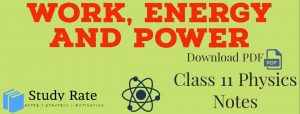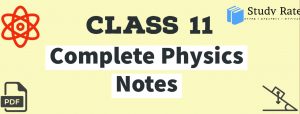In Class 11 Final Exams there will be Case studies and Passage Based Questions will be asked, So practice these types of questions. Study Rate is always there to help you. Free PDF Downloads of CBSE Class 11 Physics Chapter 9 Case Study and Passage-Based Questions with Answers were Prepared Based on the Latest Exam Pattern. Students can solve NCERT Class 11 Physics Case Study Questions Mechanical Properties of Solid to know their preparation level.
Join our Telegram Channel, there you will get various e-books for CBSE 2024 Boards exams for Class 9th, 10th, 11th, and 12th.
In CBSE Class 11 Physics Paper, There will be a few questions based on case studies and passage-based as well. In that, a paragraph will be given, and then the MCQ questions based on it will be asked.
Mechanical Properties of Solid Case Study Questions With Answers
Here, we have provided case-based/passage-based questions for Class 11 Physics Chapter 9 Mechanical Properties of Solid with answers of these Case Study Questions.
Case Study/Passage-Based Questions
Case Study 1: The graph shown below shows qualitatively the relation between the stress and the strain as the deformation gradually increases. Within Hooke’s limit for certain region stress and strain, the relation is linear. Beyond that, up to a certain value of strain, the body is still elastic and if deforming forces are removed the body recovers its original shape.

If deforming forces are removed up to which point the curve will be retraced?
(a) upto OA only
(b) upto OB
(c) upto C
(d) Never retraced its path
Answer: (b) upto OB
In the above question, during loading and unloading the force exerted by the material are conservative up to
(a) OA only (b) OB only
(c) OC only (d) OD only
Answer: (b) OB only
During unloading beyond B, say C, the length at zero stress in now equal to
(a) less than original length
(b) greater than original length
(c) original length
(d) can’t be predicted
Answer: (b) greater than original length
The breaking stress for a wire of unit crosssection is called
(a) yield point (b) elastic fatigue
(c) tensile strength (d) Young’s modulus
Answer: (c) tensile strength
Substances that can be stretched to cause large strains are called
(a) isomers (b) plastomers
(c) elastomers (d) polymers
Answer: (c) elastomers
Case Study/Passage-Based Questions
Case Study 2: According to Hooke’s law, within the elastic limit, the stress applied to a body is directly proportional to the corresponding strain.
Stress ∝ Strain

Where E is the constant of proportionality and is known as the coefficient of elasticity or modulus of elasticity. Hooke’s law is an empirical law and is found to be valid for most materials. However, there are some materials that do not exhibit this linear relationship.
According to Hooke’s law of elasticity, if stress is increased, the ratio of stress to strain
(a) decreases (b) increases
(c) becomes zero (d) remains constant
Answer: (d) remains constant
According to Hooke’s law, if stress is reduced to one-third, the ratio of stress to strain
(a) is increased to three time
(b) is decreased
(c) is zero
(d) remains constant.
Answer: (d) remains constant.
Hooke’s law defines
(a) stress
(b) strain
(c) modulus of elasticity
(d) elastic limit.
Answer: (c) modulus of elasticity
Whenever a material is loaded with elasitic limits, stress is ……… strain.
(a) equal to
(b) directly proportional to
(c) inxessely propotional to
(d) None of the above given
Answer: (b) directly proportional to
Case Study 3: A thin rod of negligible mass and cross-sectional area 4 x 10-6m-2, suspended vertically from one end, has a length of 0.5 m at 100° C, The rod is cooled to 0° C, Young’s modulus is 1011 Nm-2, Coefficient of linear expansion = 10– 5 K-1 and g = 10 ms-2
If the temperature was further reduced to -100° C, what would the rod’s final length be, assuming the coefficient of linear expansion remains constant?
a) 0.45 m
b) 0.40 m
c) 0.35 m
d) It cannot be determined with the given information.
Answer: d) It cannot be determined with the given information.
What stress would be created in the rod if it was not allowed to contract while cooling from 100° C to 0° C?
a) 1010 N/m^2
b) 1011 N/m^2
c) 1012 N/m^2
d) None of the above
Answer: b) 1011 N/m^2
If the rod were horizontally suspended and a mass of 1 kg was hung from its end, what would be the extension in the rod due to the stress caused by the weight of the mass?
a) 0.01 m
b) 0.02 m
c) 0.03 m
d) 0.04 m
Answer: a) 0.01 m
If the cross-sectional area of the rod was increased by 4 times, how would it affect the stress created in the rod from cooling from 100° C to 0° C, if the rod was not allowed to contract?
a) The stress would increase 4 times.
b) The stress would decrease 4 times.
c) The stress would remain the same.
d) The stress would become zero.
Answer: b) The stress would decrease 4 times.
If the coefficient of linear expansion of the rod’s material was doubled, how would it affect the rod’s final length when cooled from 100° C to 0° C?
a) The final length would halve.
b) The final length would double.
c) The final length would decrease but not by half.
d) The final length would increase but not double.
Answer: c) The final length would decrease but not by half.
Hope the information shed above regarding Case Study and Passage Based Questions for Class 11 Physics Chapter 9 Mechanical Properties of Solids with Answers Pdf free download has been useful to an extent. If you have any other queries about the CBSE Class 11 Physics Mechanical Properties of Solids Case Study and Passage Based Questions with Answers, feel free to comment below so that we can revert back to us at the earliest possible.
By Team Study Rate





